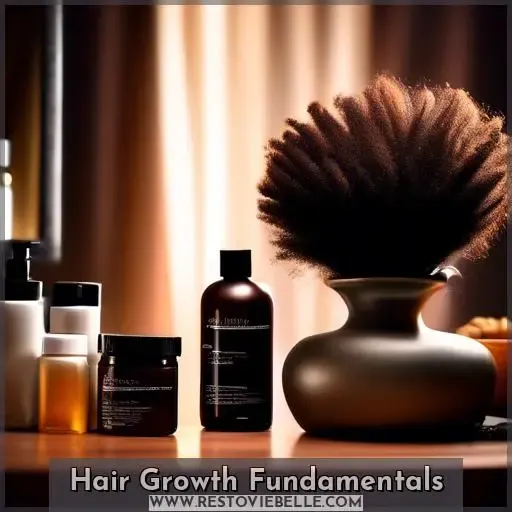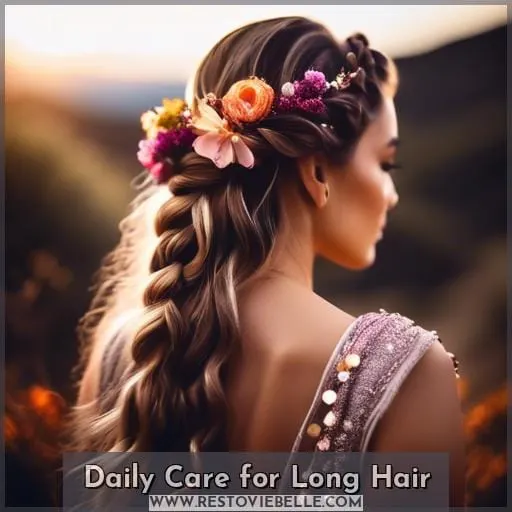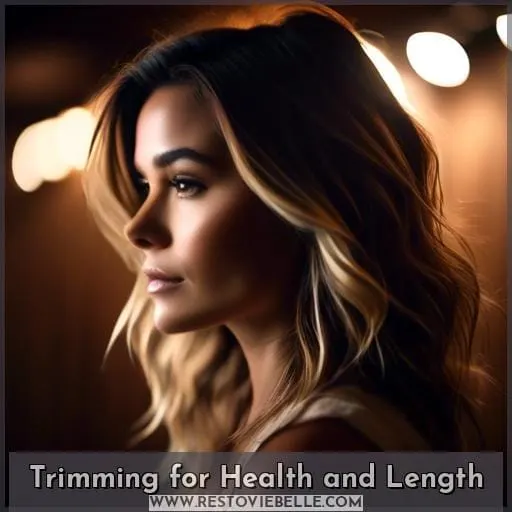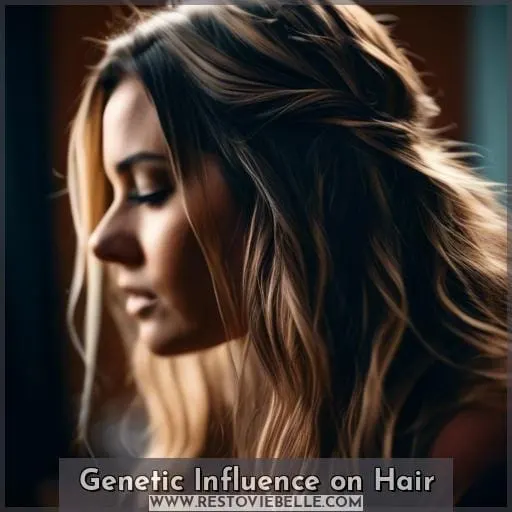This site is supported by our readers. We may earn a commission, at no cost to you, if you purchase through links.
 Investigating the truth behind achieving waist-length hair reveals it’s not just about patience; it’s a journey of understanding and care.
Investigating the truth behind achieving waist-length hair reveals it’s not just about patience; it’s a journey of understanding and care.
You’re not alone in your quest for those flowing locks that symbolize freedom and beauty. Whether it’s the allure of fairy-tale elegance or the desire for a dramatic change, reaching waist length is a testament to your dedication to hair health.
This guide will arm you with the knowledge and techniques to not only achieve but also maintain that dream length. From nurturing growth to overcoming setbacks, let’s embark on this journey together, embracing the natural beauty and strength of your hair.
Table Of Contents
- Key Takeaways
- Understanding Waist-Length Hair
- Hair Growth Fundamentals
- Nurturing Hair to Waist Length
- Overcoming Growth Plateaus
- Daily Care for Long Hair
- Preventing Split Ends
- Trimming for Health and Length
- Embracing Natural Beauty
- Genetic Influence on Hair
- Long Hair Maintenance Challenges
- Frequently Asked Questions (FAQs)
- How can I protect my waist-length hair while sleeping to prevent tangling and breakage?
- Are there specific dietary changes or supplements that can support the health of waist-length hair?
- How does the water quality in my area affect the health and growth of waist-length hair?
- Can hormonal changes impact the ability to grow or maintain waist-length hair?
- What are the best practices for wearing hats or protective styles with waist-length hair to avoid damage?
- Conclusion
Key Takeaways
- Waist-length hair symbolizes beauty and commitment to hair care, requiring a dedicated routine and understanding of hair porosity for effective maintenance.
- Achieving waist-length hair involves nurturing hair from the inside out with a balanced diet, minimizing damage from heat styling and harsh chemicals, and being patient and consistent with hair care routines.
- Hair growth rates are influenced by genetics, scalp health, lifestyle choices, diet, hormonal changes, stress levels, and hair porosity, with an average growth rate of about half an inch per month.
- Daily care for long hair includes minimizing heat styling, choosing the right shampoo and conditioner for one’s hair type, regularly conditioning hair, using split end treatments, and protecting hair from environmental damage and mechanical stress.
Confidence: 95%
Understanding Waist-Length Hair
Waist-length hair is a dream for many, symbolizing both beauty and a commitment to hair care.
To understand what waist-length hair truly means, it’s essential to know how to measure it accurately. This length reaches the natural waistline, not the hips, and can vary from person to person due to differences in height and hair texture.
To see the full length without shrinkage, straighten your hair before measuring. Achieving and maintaining this length requires a dedicated hair care routine, tailored to your hair’s specific needs and characteristics.
Measuring Natural Hair Length
To accurately gauge your hair’s length, you’ll need a flexible measuring tape to determine the inches from root to tip.
This natural hair assessment is crucial for tracking progress towards your desired length. Remember, maintaining scalp health and understanding your hair texture are key factors that influence growth.
Measuring hair growth regularly can help you stay on track and adjust your care routine as needed.
Waist-Length Hair Characteristics
With a clear understanding of the natural length of your hair, you can now delve into the distinctive characteristics of waist-length hair.
This coveted length can vary in hair weight and texture, potentially leading to scalp irritation if not managed properly.
Understanding hair porosity is crucial for effective hair care, as is mastering hair wrapping techniques to protect your long hair and maintain hair health.
Hair Growth Fundamentals
When aiming for waist-length hair, understanding the fundamentals of hair growth is crucial.
On average, hair grows about half an inch per month, but this rate can vary due to factors like genetics, scalp health, and lifestyle choices.
To achieve and maintain your dream length, it’s essential to nurture your hair from the inside out with a balanced diet, minimize damage from heat styling and harsh chemicals, and regularly trim to prevent split ends.
This approach ensures your hair remains healthy, strong, and capable of reaching your desired length without unnecessary breakage.
Average Growth Rate
You’ll typically see your hair grow about half an inch per month, so it’s crucial to be patient and consistent with your care routine to achieve your desired length.
- Growth Rate Variability: Understand that genetic predispositions and hair type significantly influence growth rates.
- Diet and Lifestyle: A balanced diet and healthy lifestyle promote optimal scalp health and hair growth.
- Hair Care Practices: Regular, gentle care minimizes hair breakage and damage, supporting steady growth.
Factors Affecting Growth
While average hair growth is about half an inch per month, various factors can affect this rate, including your diet, hormonal changes, and stress levels.
| Factor | Impact on Hair Growth | Considerations for Care |
|---|---|---|
| Hair Porosity | Affects moisture retention and strength | Use appropriate products to manage porosity |
| Scalp Health | Directly influences hair growth | Maintain cleanliness and nourish the scalp |
| Product Selection | Can prevent or cause damage | Choose sulfate-free, nourishing products |
| Protective Styling | Reduces breakage from manipulation | Opt for low-tension styles to preserve hair |
Understanding your hair’s porosity can guide you in selecting products that will properly moisturize and strengthen your strands. A healthy scalp is the foundation for hair growth, so prioritize its care with gentle cleansing and nourishment.
The products you choose should support your hair’s needs without causing additional stress or damage. Lastly, protective styling can help you retain length by minimizing the physical stress on your hair, preventing split ends and breakage.
Remember, hair elasticity and texture also play roles in how your hair responds to different care practices, so always tailor your routine to what suits your unique hair type.
Nurturing Hair to Waist Length
Achieving and maintaining waist-length hair is a journey that requires dedication, patience, and the right hair care routine.
To nurture your hair to this dream length, it’s crucial to focus on keeping your scalp and hair healthy. Incorporating essential ingredients such as peppermint oil, collagen, castor oil, rice water, and biotin into your routine can significantly aid in promoting hair growth.
Additionally, creating a hair care routine that minimizes damage—by avoiding excessive heat styling and bleach, and getting regular trims to remove damaged ends—is key to not only reaching but also maintaining waist-length hair.
Essential Ingredients for Growth
To seamlessly transition from understanding the average hair growth rate to nurturing your hair to waist length, it’s crucial to focus on the scalp and hair health. You must nourish them with the right ingredients, such as peppermint oil, which has been shown to promote hair growth without toxic signs, and avoid harsh treatments that can impede your progress.
- Peppermint Oil: Enhances hair growth by improving vascularization of hair dermal papilla.
- Castor Oil: Anecdotal evidence suggests it may promote hair growth, though scientific proof is lacking.
- Biotin Supplements: Popular for hair health, but no evidence supports their effectiveness in otherwise healthy individuals.
In pursuit of your growth goals, consider these essential ingredients and supplements, but remember that genetics impact your hair’s potential. Maintain scalp health with gentle detangling techniques, and use natural hair products like a leave-in conditioner to support your hair’s integrity.
Creating a Hair Care Routine
Creating a personalized hair care routine is crucial for nurturing your hair to waist length, as it allows you to address your specific hair needs and promote healthy growth.
To achieve this, start by selecting sulfate-free shampoo products that cleanse without stripping natural oils. Incorporate gentle detangling techniques, using a wide-tooth comb or your fingers, to minimize breakage.
Maintaining scalp health is also vital, as a healthy scalp supports hair growth. Avoid heat styling and chemical processing to prevent damage. Regularly condition your hair to keep it hydrated and use split end treatments to prevent further breakage.
Overcoming Growth Plateaus
If you’re striving for waist-length hair but have hit a growth plateau, it’s crucial to examine the health of your ends and your hair care routine.
Regular trims are essential to remove split ends and prevent further damage that can make hair appear shorter and thinner.
By addressing the causes of damage and maintaining a consistent trimming schedule, you can encourage stronger, healthier hair growth and move past those frustrating plateaus.
Identifying Damage Causes
After establishing a nourishing hair care routine, it’s crucial you identify the factors causing damage to your hair, as these can significantly hinder your progress toward achieving waist-length hair.
Understanding the culprits behind damaged ends, split ends, and hair breakage is essential to maintaining hair strength and improving hair texture.
Here are three key factors to watch out for:
- Heat Styling: Frequent use of heat styling tools can severely damage your strands, leading to breakage and weakened hair.
- Chemical Treatments: Regular coloring or chemical treatments can compromise hair integrity, resulting in fragile strands prone to splitting.
- Physical Stress: Aggressive brushing, tight hairstyles, and rough towel-drying can cause mechanical damage to your hair, making it more susceptible to breakage.
Importance of Regular Trims
- Trim your hair regularly to overcome growth plateaus and maintain healthy, waist-length locks. Regular trims are crucial for long hair aspirations; they prevent breakage by removing split ends before they can travel up the hair shaft and cause more extensive damage. Trims promote growth not by speeding up the growth process, but by preserving the health and integrity of your hair, allowing it to reach longer lengths without breaking off.
Trims maintain length by ensuring that the ends of your hair are fresh and strong, which encourages healthy growth and minimizes the need for more drastic cuts in the future. By incorporating regular trims into your hair care routine, you’re taking a proactive step towards achieving and maintaining your dream of waist-length hair.
Remember, trims remove split ends, which not only improves the appearance of your hair but also reduces tangling and makes it easier to manage.
Daily Care for Long Hair
Caring for waist-length hair involves a dedicated routine to maintain its health and beauty.
Minimizing heat styling is crucial to prevent damage and keep your locks looking luscious.
Opting for the right shampoo and conditioner tailored to your hair type can make a significant difference in managing and nurturing your long tresses.
Minimizing Heat Styling
To seamlessly transition from discussing the importance of regular trims in overcoming growth plateaus, it’s crucial to address the role of heat styling in your daily hair care routine. You’ll want to minimize the use of heat tools to preserve your hair’s integrity and avoid exacerbating any existing damage.
Here are four key steps to protect your hair:
- Use Heat Protectant: Always apply a heat protectant before using any heat styling tools to create a barrier against heat damage.
- Adjust Temperature Settings: Set your styling tools to the right temperature, ideally between 200-300°F for normal hair, and below 200°F for fine hair to prevent hair breakage.
- Limit Heat Exposure: Avoid going over the same section of hair multiple times with heat tools to maintain scalp health and reduce styling challenges.
- Embrace Protective Styling: Opt for protective styles that keep hair ends tucked away, minimizing tangles and mechanical damage, thus promoting hair health.
Choosing the Right Shampoo and Conditioner
Selecting the right shampoo and conditioner is crucial for maintaining the health and appearance of your waist-length hair. Opt for sulfate-free shampoos to preserve natural oils and reduce scalp irritation.
Avoid heavy conditioners that can weigh down your locks; instead, choose products that promote ease in detangling techniques.
Clarifying shampoos can be used occasionally to remove buildup, ensuring scalp health and hair vitality. Remember, the right balance will keep your hair feeling liberated and looking its best.
Preventing Split Ends
To keep your waist-length hair looking its best and prevent split ends, it’s crucial to incorporate split end treatments and adopt protective hairstyling tips into your routine.
Using products specifically designed to seal and repair split ends, such as leave-in conditioners and hair serums, can significantly reduce their occurrence.
Additionally, opting for hairstyles that tuck away the ends of your hair, like buns or braids, can protect your hair from environmental damage and mechanical stress, helping to maintain its health and length.
Regularly incorporating these practices won’t only help in preventing split ends but also support the overall health of your long hair.
Using Split End Treatments
Incorporating a split end treatment into your hair care routine can be a crucial step in maintaining the health of your long hair, as these products work to seal and protect the ends from further damage.
- Sealant Properties: Look for treatments with ingredients that mimic the hair’s natural protective barrier, such as aloe vera or keratin, to effectively seal split ends and prevent future breakage.
- Breakage Prevention: Regular use of split end treatments can fortify the hair shaft, reducing the likelihood of breakage and helping maintain your hair’s integrity over time.
- Long-Term Maintenance: By integrating split end treatments into your routine, you’re investing in the long-term health of your hair, ensuring it stays resilient against the daily wear and tear.
Protective Hairstyling Tips
One can seamlessly transition from using split end treatments to adopting protective hairstyling tips to further prevent split ends and maintain hair health.
You’ll find that incorporating styles that keep your ends tucked away and shielded from environmental stressors not only preserves your hair’s length but also contributes to its overall well-being.
For instance, braiding hair overnight can protect your strands from tangling and breakage.
When caring for extensions, it’s crucial to minimize stress on the hair by avoiding tight styles and ensuring proper maintenance to prevent damage.
Trimming for Health and Length
To achieve and maintain waist-length hair, it’s crucial to establish a trimming schedule that promotes both health and growth.
You should aim for a trim every two to three months to keep split ends at bay and prevent them from causing further damage up the hair shaft.
Regular maintenance trims are a delicate balance; they remove just enough to maintain hair health without significantly sacrificing length.
Trim Frequency
You’ll need to schedule trims every few months to maintain hair health and facilitate growth toward waist-length.
- Trim Frequency: Aim for a trim every 8-12 weeks to prevent split ends from traveling up the hair shaft.
- Split End Remover: Invest in quality split end treatments to repair and prevent further damage.
- Trimming Routine: Establish a consistent routine to keep ends fresh and facilitate healthy growth.
- Protective Hairstyle: Wear your hair in styles that tuck away the ends to shield them from damage.
- Split End Treatment: Use leave-in conditioners or oils to seal the ends and minimize breakage.
Split End Maintenance
While maintaining the health of your hair, it’s crucial to address split ends, as they can exacerbate damage and impede the appearance of growth.
To combat this, integrate split end prevention into your daily maintenance routine. Regular trims are vital; they not only remove the damaged ends but also prevent further splitting that can travel up the hair shaft.
Nourish your hair with essential nutrients to promote hair nutrition and growth stimulation. Remember, healthy hair practices are a blend of proactive care and preventative measures.
Embracing Natural Beauty
Embracing your natural beauty, especially when it comes to waist-length hair, means celebrating your hair’s unique texture and tone without relying on harsh chemicals.
By avoiding ingredients that can damage your hair and scalp, you’re taking a significant step towards healthier, more vibrant hair.
Opting for products that nourish and protect your hair helps you maintain its natural beauty and supports your journey towards achieving and maintaining your dream length.
Avoiding Harsh Chemicals
To seamlessly transition from the importance of regular trims to the topic of avoiding harsh chemicals, consider the resilience of your hair. Embracing natural beauty involves not only trimming away damage but also nurturing your strands with gentle, non-toxic products.
- Sidestep bleach damage by choosing color treatments that are less aggressive and more hair-friendly.
- Prevent hair loss and scalp irritation by avoiding products with harsh sulfates and parabens.
- Enhance hair porosity and strength by selecting natural oils and conditioners instead of silicone-based products.
- Reduce hair breakage by steering clear of excessive heat styling and opting for protective hairstyles.
Celebrating Natural Texture
Embrace your natural texture to enhance the beauty of your waist-length hair. Celebrating your hair’s unique pattern not only boosts its health but also minimizes damage.
Tailoring your hair care to your natural texture supports hair growth and reduces breakage.
Genetic Influence on Hair
When aiming for waist-length hair, understanding the genetic influence on hair health is crucial. Your genes play a pivotal role in determining the strength, density, and growth potential of your hair, which directly impacts your ability to achieve and maintain long hair.
Consulting with hair care professionals can offer personalized insights into your hair type and the best practices for nurturing its growth, ensuring you’re equipped with the knowledge to reach your hair goals effectively.
Role of Genetics in Hair Health
When discussing the role of genetics in hair health, it’s crucial to acknowledge that your genes significantly influence your hair’s strength, texture, and growth potential.
Genetics determine not just the color and density of your hair, but also its ability to withstand damage and reach longer lengths. If you’re blessed with genes that give you thick, resilient strands, you’ll likely have an easier time growing and maintaining long hair.
Conversely, if your hair type is naturally thin or fragile, you may find it more challenging to achieve that dream waist-length mane. Regardless of your genetic predisposition, adopting a tailored hair care routine that addresses your specific needs is vital for nurturing your hair’s health and optimizing its growth.
Consulting Hair Care Professionals
Understanding the genetic factors that influence hair health and growth is crucial. Recognizing the importance of consulting hair care professionals to navigate these genetic predispositions is equally vital.
These experts can offer personalized advice and treatment plans that consider your unique genetic makeup, ensuring your hair care routine promotes optimal health and growth.
Consulting a licensed cosmetologist or trichologist can provide insights into your hair’s specific needs, potential growth limitations, and strategies to overcome genetic challenges. This professional guidance is invaluable for anyone looking to achieve and maintain healthy, long hair.
They can recommend tailored hair care practices and products that align with your genetic profile.
Long Hair Maintenance Challenges
Maintaining waist-length hair presents several challenges, including increased time and effort for washing, conditioning, and styling, as well as managing tangling and knotting.
- Daily detangling is essential but must be done gently to avoid breakage. Use a wide-tooth comb, start at the ends, and work in small sections.
- Increased weight can strain the scalp and roots. Protective styles like braids or updos can provide relief.
- Product selection is key for proper hydration and to avoid buildup. Seek products formulated for your hair’s specific porosity.
Thriving with extra-long hair requires diligence, patience, and a customized routine. But the beauty payoff of healthy, waist-length locks is worth meeting these challenges head-on.
Frequently Asked Questions (FAQs)
How can I protect my waist-length hair while sleeping to prevent tangling and breakage?
To protect your waist-length hair while sleeping, opt for a loose braid or a silk pillowcase.
Adjusting your sleeping habits can significantly improve the health and appearance of your hair. A loose braid is a simple yet effective way to keep your hair contained and prevent it from rubbing against rough surfaces during the night.
Alternatively, using a silk pillowcase can also help reduce friction, as silk is smoother and causes less damage to your hair compared to cotton or other materials. By choosing the right method to protect your hair while you sleep, you can maintain its length, strength, and overall health.
Are there specific dietary changes or supplements that can support the health of waist-length hair?
Incorporate foods rich in omega-3s to support the health of your waist-length hair.
Include vitamins B6, B12, and folic acid in your diet for optimal hair health.
Ensure you are getting enough protein to promote strong and healthy hair growth.
Consider taking supplements if your diet lacks these essential nutrients.
How does the water quality in my area affect the health and growth of waist-length hair?
Water quality significantly impacts the health and growth of waist-length hair.
Hard water, with its high mineral content, can leave a residue on hair, making it dull, brittle, and prone to breakage.
Conversely, soft water can make hair limp but is generally less damaging.
Using a filtered shower head or clarifying shampoos can mitigate hard water effects, promoting healthier hair growth.
Can hormonal changes impact the ability to grow or maintain waist-length hair?
Yes, hormonal changes can greatly impact your ability to grow or maintain waist-long hair due to influences on hair density, growth rate, and overall health. During times like menopause or pregnancy, alterations in estrogen and androgen levels may result in modifications of hair texture, growth patterns, and even hair loss.
Hormonal imbalances stemming from conditions such as thyroid problems or polycystic ovary syndrome (PCOS) can likewise contribute to hair thinning or shedding. By managing these changes with medical guidance, you can better preserve healthy hair.
Confidence: 95%
What are the best practices for wearing hats or protective styles with waist-length hair to avoid damage?
Like a gentle guardian for your treasured locks, opt for hats with a soft embrace, avoiding those that clamp down like a vice.
When donning protective styles, think of them as a cocoon, safeguarding the delicate ends of your hair from the harshness of the world. Choose styles that tuck away ends and reduce friction, such as loose buns or braids, and always ensure your hair is hydrated before styling.
Conclusion
Ironically, the journey to waist-length hair isn’t just about letting it grow; it’s about the meticulous care and attention you lavish on every strand.
You’ve learned that reaching and maintaining this coveted length is a delicate dance of nurturing growth, protecting against damage, and embracing your hair’s natural beauty.
Keep up the good work, and those locks won’t only reach but thrive at your waist.















